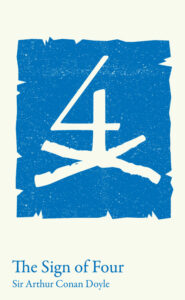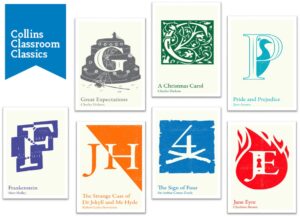Before we start I have to admit something; before writing this blog I’d never read any Sherlock Holmes stories… in fact I’d totally dismissed them assuming they were dry and dull and not understanding the nation’s love for them. I stand wholly corrected. The Sign of Four is a short but tightly packed detective story about treasure, double-crossing, betrayal, love, murder and greed. It is broken in to precise chapters which makes it perfect for segmenting in the classroom. In addition the character of Sherlock Holmes as seen through the eyes of Dr John Watson is as fascinating study who is incredibly clever but totally lacking any kind of emotional intelligence. His observations are both astute and at times hilarious. This story is accessible to all abilities as well as being a lively and enjoyable read. The opening had me hooked instantly, I had not expected a scene of hard drug use in a Victorian novel, nor had I expected the dry wit, exasperation and commentary from Watson who almost translates Holmes’ oddities and genius for the reader.
5 discussion points
- Read the opening few passages on Holmes’ habitual cocaine habit, discuss with a partner the following points:
a). How do you feel reading this?
b). How does Watson feel?
c). What initial impression are we given of Holmes’ here?
d). Why do you think Conan Doyle begins the novel with this scene?
e). How does Holmes justify this drug use and what does this tell us about his character?
f). Have you read any other novels with scenes like this?
g). Did you expect to find such a scene in a Victorian novel?
- In what way is Watson a foil to Holmes?
Ask students to create a mind map for each character, sketching an image and surrounding them with quotes and impressions of each man. How does the character of Holmes (empathetic, romantic, sensitive) compare to Sherlock (nonchalant, mechanical, calculating) and how does Doyle use Watson to show Sherlock’s faults and comparatively, Sherlock show Watson’s faults? Which character do they favour and why?
- Ask students to focus on a key character of their choice. In the exam they may be asked ‘How Doyle presents the character’, can they comment on this now?
For example Miss Morstan in chapter 2 is described in very contrasting ways that both reveal the same thing, she is a damsel in distress needing male assistance. Mr Sholto in chapter 4 is also described as a weak character in need of assistance. You may like to direct them first to a selected extract and then to the novel overall so that they can discuss both how the character is presented in the extract and then in the novel overall.
- In your opinion, how does Doyle create suspense and keep the reader intrigued?
Students should consider:
a). information given – for example we only see from one perspective, at times in the dark, through key holes or even in the haze of London smog
b). the use of different sentence types and punctuation to guide the reader
c). language devices used
d). how a sense of suspicion is created – what is interesting about the footprints at the crime scene for example?
e). images used – a man’s face at the window, a sign of four left on a body, footprints, a poisoned thorn, a pearl, treasure chests
- How important is setting to the story? Pay particular attention to the Pondicherry Lodge. Students may like to draw the scene as it is described on mini whiteboards as you read aloud, stopping to discuss reasons why these snippets of description are important and how they make the reader feel. For example, why do we arrive in the dead of night? Why is the gravel crunching on the drive an important feature? How does hearing sobbing make us feel?
5 Activities
- Treasure chest game / revision tool
If you can borrow a treasure chest here from the drama department than all the better, otherwise you could have students decorate a box for you or create one on the IWB with images of treasure that can be removed. Items could be drawings made in class, objects found from home and other classrooms or set as a homework task.
Fill your treasure box with items that relate to the story such as pearls, a note with the sign of four, an engagement ring, a piece of treasure, an item that is related to India and a thorn. It would be lovely to discuss what items your students would like to include and go from there. Once all the treasure is inside the box remove a few items and ask students if they can remember what has been removed followed by how it relates to the story. You could also add extension questions as you go such as ‘I see you have the pearl. Which character would you say this is a metaphor for and why?’
- PSHE/Citizenship link – group or class discussion opportunity
Doyle’s Victorian language is both archaic ‘native’ ‘savages’ and offensive in places, especially in Sherlock’s descriptions of the criminals on p.82. What issues do students have with this language? What do they think are the implications of being taught this both now and in the Victorian era? Can they relate it to today’s issues? Do we assume that they didn’t know any better or do we challenge this language? What happens if language that is deemed racist or indeed offensive in anyway isn’t challenged? Is not correcting someone who uses this language as bad as using it yourself?
- Damsel in distress drama activity
A common feature in Doyle’s books is the arrival of female character who is in need of rescuing. Miss Morstan learns that she has no treasure but feels no loss as she now has a new fiancé and love is more important than money…right? Ask students to discuss this statement and then create a drama scene with an alternative ending that they feel is more suited and more modern. If they agree with the statement they may like to re-enact the original scene or give Mary more of a chance to express herself or even address the audience with her thoughts.
- Debate
A). Sherlock is a hypocrite as he finds criminals yet he himself is a drug addict
B). Sherlock’s addictions make him a stronger man
Which statement do students most agree with? Can they create a 1 minute speech to persuade us and be ready to defend their opinion to the opposition?
- Language warm up
Using unusual terms from the novel, can students come up with a definition and an alternative term? They can use dictionaries if they like and bonus points for creative alternative terms
Malodorous ~ means something disgusting smelling ~ stinking to high heaven like the boys toilets
Loath
Despondent
Blundered
Whimsical
By Joanna Fliski
Joanna Fliski has taught English Literature and Language to 11-18 year olds at an urban comprehensive secondary school for 10 years, she had the highest value added score for her students and was nominated for an outstanding teacher award. As well as teaching Drama and Media GCSE she was head of PSHE, trained teachers and is a behavioural specialist. Joanna currently teaches in primary schools in Bristol. She is also a freelance author, writing resources and teacher guides for the Cambridge IGCSE, creating schemes of work and contributing to a number of educational blogs.
Collins Classroom Classics
Just £1.50 each for schools!
New for January 2019 are the Collins Classroom Classics: the complete 19th century novels accompanied by introductions and glossaries written by experienced teachers. They are designed to help students understand the context in which each novel was written in.





